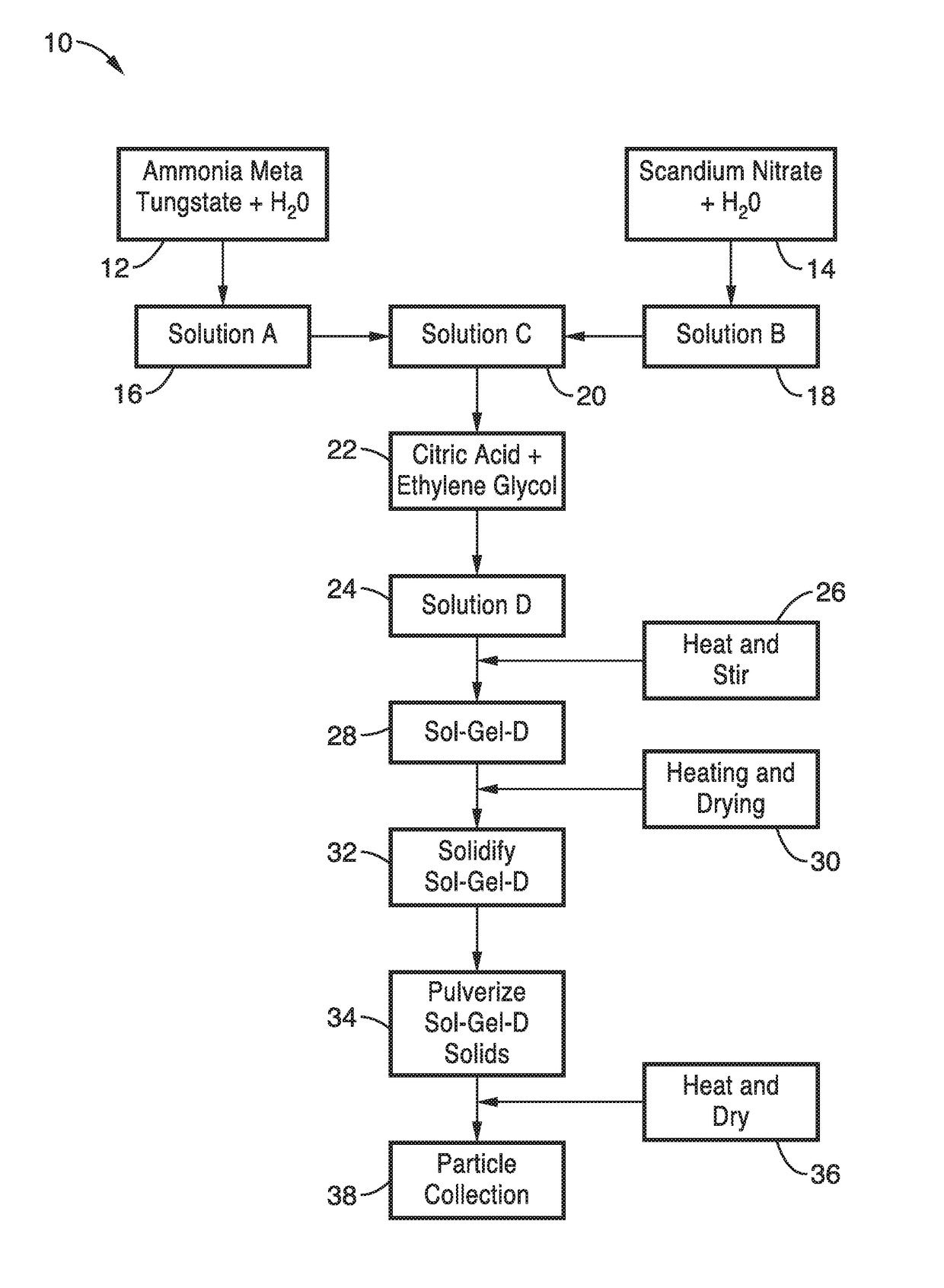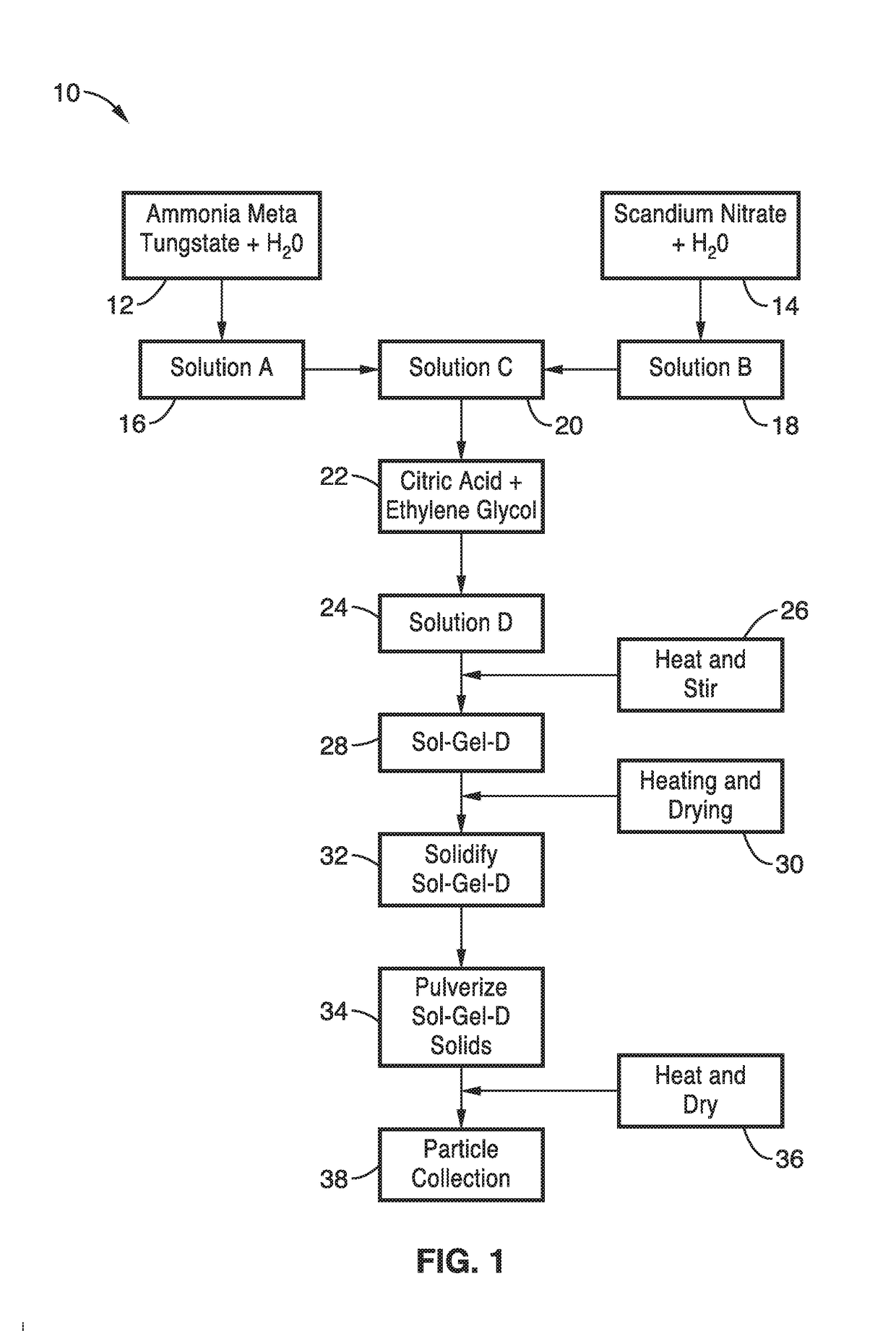Method of fabricating tungsten scandate nano-composite powder for cathodes
a technology of tungsten scandate and composite powder, which is applied in the direction of discharge tube/lamp details, basic electric elements, chemistry apparatus and processes, etc., can solve the problem that commercially available cathodes do not produce an adequate amount of current density, and achieve uniform distribution of emissive materials, improve emission uniformity, and reduce the work function of the emission surface
- Summary
- Abstract
- Description
- Claims
- Application Information
AI Technical Summary
Benefits of technology
Problems solved by technology
Method used
Image
Examples
example 1
[0067]In order to demonstrate the fabrication methods, a nanocomposite 5% scandate tungsten powder was produced, formed into a cathode structure and tested. In this example, about 25.468 grams of ammonium meta tungstate [(NH4)6H2W12O40] was mixed with between 100 ml to about 300 ml of deionized water and the solution was stirred to with to dissolve the salt to produce a first solution. Then, about 3.366 grams of scandium (III) nitrate [Sc(NO3)3] was mixed with about 20 ml to about 200 ml of deionized water with scandium nitrate; stir the solution to dissolve the salt and produce a second solution. The weight of the scandium (III) nitrate can be adjusted accordingly to achieve a lower or higher percentage of scandia in the final powder. The preferred percentage of scandia is between about 2% and about 8% by weight.
[0068]The first and second solutions were combined in a flask and about 10 grams to about 30 grams of citric acid [C6H8O7] and ethylene glycol, [99%, C2H6O2], were added an...
example 2
[0074]To further demonstrate the technology, several quantities of ammonium metatungstate / (NH4)6H2W12O40 and scandium(III) nitrate / Sc(NO3)3 were weighed and mixed with deionized water and stirred to produce solutions. Specifically, 200 mL of deionized water was added to the ammonium meta tungstate in a 300 mL beaker and placed on a stirring plate and spun at 350 RPM's to dissolve the chemicals. Similarly, the scandium nitrate was placed in 100 mL of deionized water and then put on a stirring plate and spun at 350 RPM's to dissolve chemicals.
[0075]Equal parts ethylene glycol and citric acid / C6H8O7 were mixed in a 50 mL beaker, first ethylene glycol and then the citric acid was added. The scandium and tungstate solutions were combined and placed into a 500 mL Erlenmeyer flask and then 20 grams of citric acid and ethylene glycol were immediately added to the Erlenmeyer flask.
[0076]A heated oil bath was prepared by filling a Pyrex beaker (No. 3140) with silicone oil halfway up the beake...
example 3
[0088]To illustrate the electron beam emission characteristics of the structure, a microcomposite scandate dispenser cathode was prepared and evaluated. The prepared porous tungsten scandate pellets were impregnated with barium-calcium-aluminates with a molar ratio of 4:1:1. This resulted in the filling of the pores of the tungsten matrix with emission materials.
[0089]Initially, the barium nitrate / Ba(NO3)2, calcium nitrate / Ca(NO3)2 and aluminium nitrate hydrate / Al(NO3)3*XH2O starting materials were prepared in the proper molar ratios. The starting impregnation materials (5.115 grams of barium nitrate, 1.1505 grams of calcium nitrate and 3.659 grams of aluminum nitrate hydrate) were added to 180 mL of deionized water in a 500 mL beaker to produce a solution. The solution was stirred at 200 RPM's to dissolve and mix things thoroughly.
[0090]An ammonium carbonate (CH8N2O3) solution was added dropwise to the solution of impregnation materials while stirring the solution until a precipita...
PUM
| Property | Measurement | Unit |
|---|---|---|
| porosity | aaaaa | aaaaa |
| porosity | aaaaa | aaaaa |
| temperature | aaaaa | aaaaa |
Abstract
Description
Claims
Application Information
 Login to View More
Login to View More - R&D
- Intellectual Property
- Life Sciences
- Materials
- Tech Scout
- Unparalleled Data Quality
- Higher Quality Content
- 60% Fewer Hallucinations
Browse by: Latest US Patents, China's latest patents, Technical Efficacy Thesaurus, Application Domain, Technology Topic, Popular Technical Reports.
© 2025 PatSnap. All rights reserved.Legal|Privacy policy|Modern Slavery Act Transparency Statement|Sitemap|About US| Contact US: help@patsnap.com



